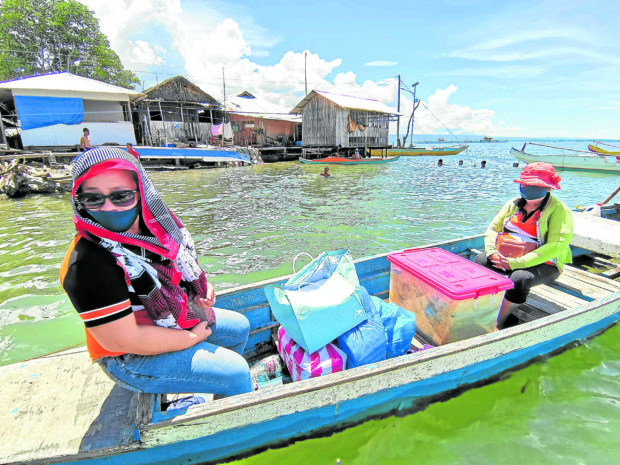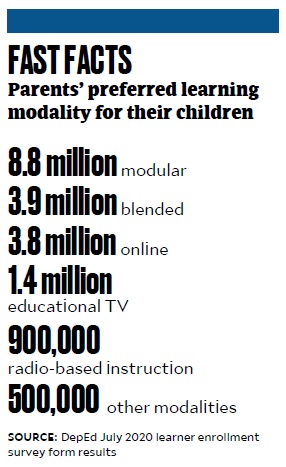Teachers, parents brace for double workload, unfamiliar tools

Teachers of Darumawang Bucana Elementary School take a boat to bring the learning modules to remote areas in the island of Darumawang Bucana, in Lala town, Lanao del Norte, October 3. (Divina M. Suson)
MANILA, Philippines — As more than 24 million public school students begin the unprecedented venture of distance and blended learning, school principal Rowan Celestra does not expect his Grade 4 students to raise their hands before their computer screens and seek clarifications on their lessons.
Instead, he anticipates a slew of questions from not a few stressed parents who have also done some learning themselves—studying for months the modules that would serve as their children’s source of knowledge.
“I told them (the parents) to begin scanning the modules over the weekend so they could anticipate the lessons that their children may have a hard time understanding,” said Celestra, the principal at Buenavista Elementary School in Sorsogon province for five years now.
Teachers at his school worry about whether their orientation with the parents has been enough to facilitate distance learning and for them to monitor the performance of their students.
Months before Monday’s school opening, Celestra and his faculty scrambled to print and distribute the modules on time, doubling their usual workload. They brought home heaps of bond papers to print almost 2,000 modules for their 244 basic education students.
Article continues after this advertisementAs funds provided by the Department of Education (DepEd) for the printing of materials were released only in September, or a month before classes reopened, Celestra and his colleagues decided to allocate the school’s maintenance and other operating expenses to purchase bond papers.
Article continues after this advertisementTypes of distance learning
Because of the suspended face-to-face classes amid the continuing threat of the COVID-19 pandemic, the DepEd is implementing three types of distance learning: online learning, modular distance learning and TV/radio-based instruction.
Self-learning modules will be made available in print or digital formats.
Electronic copies of the learning materials may be delivered through CDs, DVDs, USBs or offline e-books. These are also available through the DepEd Commons, an online platform that may be accessed for free through Globe or Smart.
Under modular distance learning, printed modules will be handed to and retrieved from the parents weekly. The modules will come with other reference books which schools will lend to students.
According to a DepEd survey conducted in July, 71 percent of parents, or 8.8 million, prefer modular learning for their children over other distance learning modes.
The department also said modules were the “backbone” of distance and blended learning, as these would become the main instrument for instruction to be supplemented by TV, radio or video lessons.
Last week, the DepEd said it still had about 20 percent of modules, or around 134.4 million, that needed to be distributed to public school students in the country as it emphasized that the status of distribution must not be used to measure readiness.
In Pasig City, where all students are expected to learn through modules, teacher Myrvyne Tesorero said educators were now challenged to properly teach the contents of the modules and help learners master the different learning competencies when internet connection and mobile data turn spotty.
“How will students catch up on the discussion if they do not have load? That is not even their priority now because load is not their only problem … We are hoping that teachers will not carry this burden because their last resort would be to risk their health and conduct home visits,” she said.
Communication system
Celestra resorted to devising a communication system for his school in the form of E-Nay.com, or Education for Nanay in the Community, wherein teachers would build the capacity of parents to understand teaching and conduct workshops on instructional materials.
This initiative, which was backed by the DepEd, paved the way for the establishment of one E-Nay center for each community, wherein parents could raise their concerns and the school could assist in the home instruction.
There is also the problem of familiarizing oneself with the tools of online learning.
Like other parents and teachers around the country, Joy dela Cruz of Sibonga town in southern Cebu forced herself to learn such applications as Google Classroom, which Google developed for schools that aim to simplify creating, distributing and grading assignments.
“If you are not a techie parent, it’s really difficult at first,” said the 40-year-old mother.
Her two daughters, Grade 3 and Grade 4 students at Bahay Elementary School, are just as unfamiliar with online technology as their mother. Dela Cruz has to guide them in accessing links and using the apps in their online classes, which are held at 8 a.m. to noon on school days.
Quality of education
The most critical aspect of education amid the pandemic is ensuring its quality.
Celestra expressed concern as to how reading is taught in kindergarten and primary school, since parents, who are not trained teachers, may teach the wrong phonetics to their children which they could carry until adulthood.
At Digos City National High School, principal Roger Manapol, who also teaches social science, said “In modular learning, students would be alone to read the modules and there’s a lesser chance for them to dissect what [is] being written there because of the absence of face-to-face interaction.”
He added that “In the modular classroom, their parents [would become] their teachers and the usual [complaint] has been that the parents have not been trained to teach these subjects. They are not actually ready to deal with it.”
“We cannot just bombard ourselves with eight subjects in one go, we would have indigestion,” he also pointed out.
Ruth Leron Basco, who teaches English to Grade 5 and Grade 6 pupils in the village of Bala in Magsaysay town, Davao del Sur province, said she had adjusted to preparing and even designing the modules, but is anxious as to how her pupils would take them.
“I don’t know if they can answer everything that [the modules require them to answer]. They will have to read the lessons on their own,” she said.
—With reports from Eldie Aguirre, Nestor P. .Burgos Jr., Joey Gabieta, Jigger J. Jerusalem, Ador Vincent Maol, Nestle Semilla and Leo Udtohan
For more news about the novel coronavirus click here.
What you need to know about Coronavirus.
For more information on COVID-19, call the DOH Hotline: (02) 86517800 local 1149/1150.
The Inquirer Foundation supports our healthcare frontliners and is still accepting cash donations to be deposited at Banco de Oro (BDO) current account #007960018860 or donate through PayMaya using this link.
